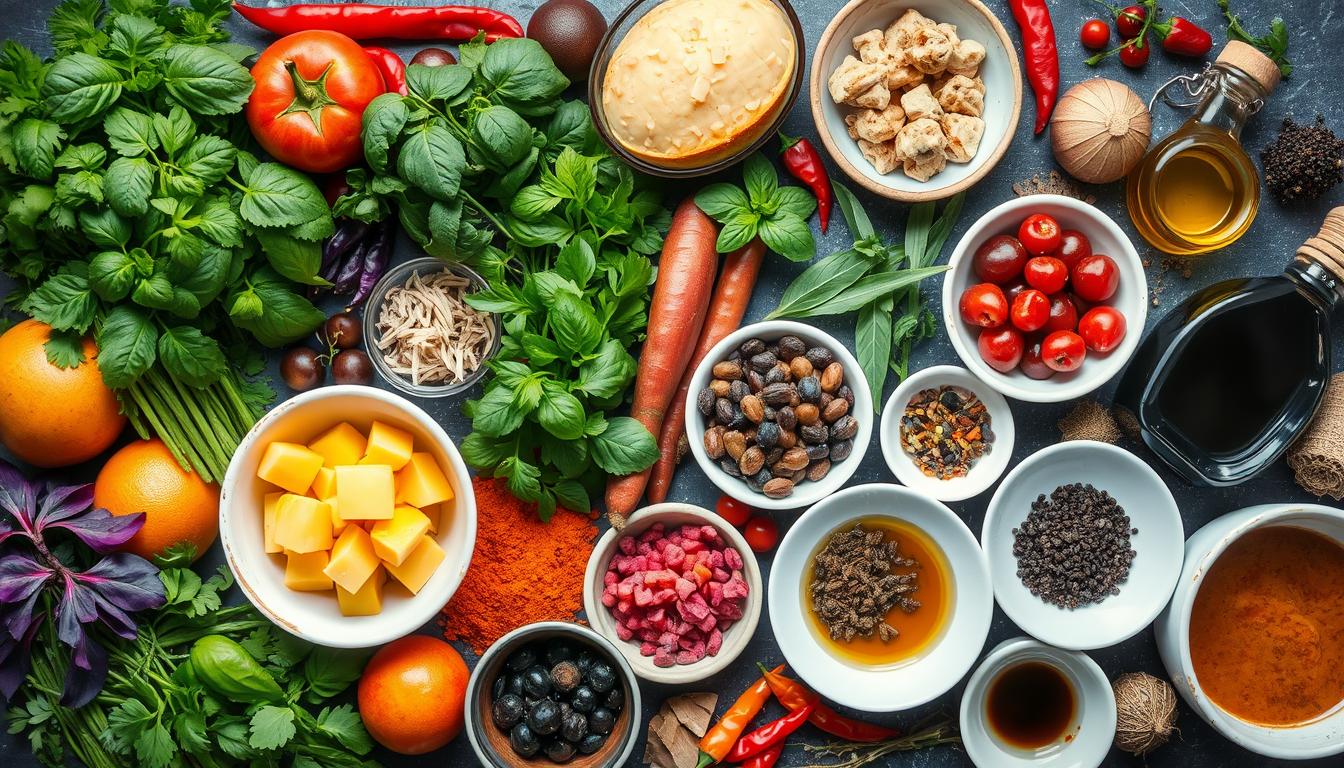Have you ever taken a bite of something so delicious that it transported you to a memory—a family gathering, a moment in time, or perhaps a special celebration? The power of flavors goes beyond mere taste; it evokes emotions and connects us to our past. In the realm of culinary exploration, understanding top flavor combinations can elevate your cooking game to new heights. Whether it’s the creamy delight of chocolate and peanut butter or the refreshing zest of lemon paired with seafood, discovering creative flavor combinations can transform everyday meals into memorable experiences.
As you embark on this flavorful journey, you’ll find that familiar flavors can act as a bridge to new and unexpected tastes. With 10 out of 20 recipes showcasing fruit as a central component, let’s dive into the art of flavor pairing and find the delicious flavor blends that resonate with your palate.
Key Takeaways
- 10 out of 20 recipes feature fruit as a main flavor component.
- Lavender appears in 10% of the recipes, adding a unique floral touch.
- Garlic and lemon enhance the flavors in multiple recipes.
- Classic blends like chocolate and peanut butter are timeless.
- Innovative pairings, such as raspberries with dark chocolate, create sophisticated profiles.
- The balance of flavors is essential for unforgettable dishes.
The Art of Flavor Pairing
Flavor pairing is an essential skill for any aspiring cook. Understanding how to combine different tastes creates an exciting culinary experience. This art involves recognizing complementary tastes that enhance dishes and crafting flavor harmony that captivates the palate.
At the core of flavor pairing is the flavor wheel, which categorizes flavors into primary, secondary, and tertiary groups. This tool helps chefs identify which flavors naturally complement each other. For example, Umami-rich ingredients like mushrooms, soy sauce, and Parmesan cheese can deepen the overall flavor of a dish. A classic pairing, such as Parmesan with ripe tomatoes, showcases how umami elements elevate a simple meal.
Contrast plays a significant role in flavor pairing as well. Pairings like sweet and salty or acid and fat create excitement and balance. Envision a salty caramel dessert that intrigues the taste buds. The subtle interplay between contrasting flavors brings a dynamic element to your dishes.
Modern techniques like molecular gastronomy take flavor pairing to new heights. Techniques such as spherification and foaming transform ordinary ingredients into extraordinary creations. This innovative approach allows for unexpected flavor partnerships that surprise and delight.
Exploring global fusion cuisine unveils even more potential for interesting flavor combinations. Merging techniques and ingredients from various cultures, you may find delightful pairings like Korean tacos—blending robust Korean barbecue flavors with the casual enjoyment of a taco.

Embrace the world of flavor pairing, allowing your creativity in the kitchen to flourish. Focus on the science behind tastes and the beauty of complementary flavors. Experimentation will lead you to discover unique and delicious culinary harmonies that impress everyone at your table.
| Flavor Type | Examples | Complementary Pairings |
|---|---|---|
| Sweet | Chocolate, Honey | Salt, Fat |
| Salty | Cheese, Soy Sauce | Sweet, Sour |
| Sour | Lemon, Vinegar | Fat, Sweet |
| Bitter | Dark Chocolate, Coffee | Sweet, Umami |
| Umami | Mushrooms, Tomato | Acidic, Sweet |
Understanding Flavor Profiles
Flavor profiles are essential in defining how dishes yield delightful sensations on our palate. By grasping the concept of flavor combinations, you can elevate your culinary creations and engage your guests’ taste buds effectively. The foundation of any robust flavor profile lies in the primary flavors: sweet, sour, salty, and bitter. Each flavor serves a significant role in meal preparation, creating a harmonious balance that enhances every bite.
Primary Flavors: Sweet, Sour, Salty, and Bitter
There are five primary tastes that you should be aware of when constructing flavor profiles: sweet, sour, salty, bitter, and umami. Each of these flavors can evoke distinct responses and transform an ordinary meal into an extraordinary experience. For instance, Thai cuisine beautifully showcases the balance of sweet, sour, salty, and spicy flavors, especially in dishes like Tom Yum soup. Understanding how these primary flavors interact helps create dishes that not only satisfy but also surprise.
Secondary and Tertiary Flavors
Beyond the primary flavors, secondary and tertiary flavors come into play, adding depth and complexity to your dishes. Ingredients such as herbs and spices—like cilantro, cumin, and coriander—play significant roles in different ethnic cuisines, enhancing their unique flavor profiles. For example, Northern and Southern Italian cuisines feature distinct flavor combinations influenced by climate and local traditions. Regionally sourced ingredients, seasonal produce, and aromatic herbs contribute to a dish’s overall taste, making it essential to understand how these components work together. Ultimately, achieving a well-rounded flavor profile will lead to an unforgettable dining experience.

Classic Flavor Combinations That Never Fail
Some flavor marriages have earned their status as classic flavor combinations cherished for generations. These timeless duos offer not just taste but also nostalgia and comfort in every bite. Here are three combinations that highlight why certain flavors pair so beautifully together.
Chocolate and Peanut Butter
The marriage of chocolate and peanut butter creates a rich, creamy delight that resonates with many. Whether in a classic candy bar or a decadent cake, the balance of sweetness and a slight nuttiness delivers an unforgettable flavor experience. This iconic duo embodies one of the most beloved classic flavor combinations, captivating palates and evoking fond memories.
Tomatoes and Basil
Imagine a sunny Mediterranean garden; this is what the pairing of tomatoes and basil brings to mind. Their refreshing relationship shines in a Caprese salad, where the tangy sweetness of ripe tomatoes meets the aromatic notes of fresh basil. Each bite unfolds layers of flavor, making it a celebrated example of timeless duos that elevate everyday meals.
Pineapple and Coconut
Transport yourself to a tropical paradise with the sweet and creamy combination of pineapple and coconut. Often found in beverages or desserts, this flavor marriage provides a refreshing escape that reminds you of sandy beaches and warm sunshine. Both ingredients sing in harmony, making it one of the quintessential classic flavor combinations you can enjoy year-round.

Unique Flavor Pairings to Experiment With
For those seeking to elevate their culinary creations, exploring unique flavor pairings can lead to unforgettable taste experiences. Embracing flavor fusion allows you to venture beyond traditional combinations and push the limits of your palate. The following pairings invite experimentation and challenge boundaries, encouraging you to explore new culinary territory.
Chocolate with Chili Peppers
Combine the rich, velvety texture of chocolate with the kick of chili peppers for a surprising union. This unique flavor pairing balances sweetness with heat, creating a tantalizing contrast. The warmth of the chili enhances chocolate’s depth, making each bite an adventure for your taste buds. This daring fusion calls for you to step out of your comfort zone, embracing experimentation with varying degrees of heat.
Kiwi and Oysters
This intriguing pairing brings together the tartness of kiwi and the brininess of oysters for a refreshing culinary experience. The fruity acidity of kiwi cuts through the rich flavor of oysters, creating a harmonious balance that intrigues the senses. As you try this unique flavor pairing, focus on the textural contrasts and embrace fresh, seasonal ingredients to maximize the overall enjoyment of each bite.
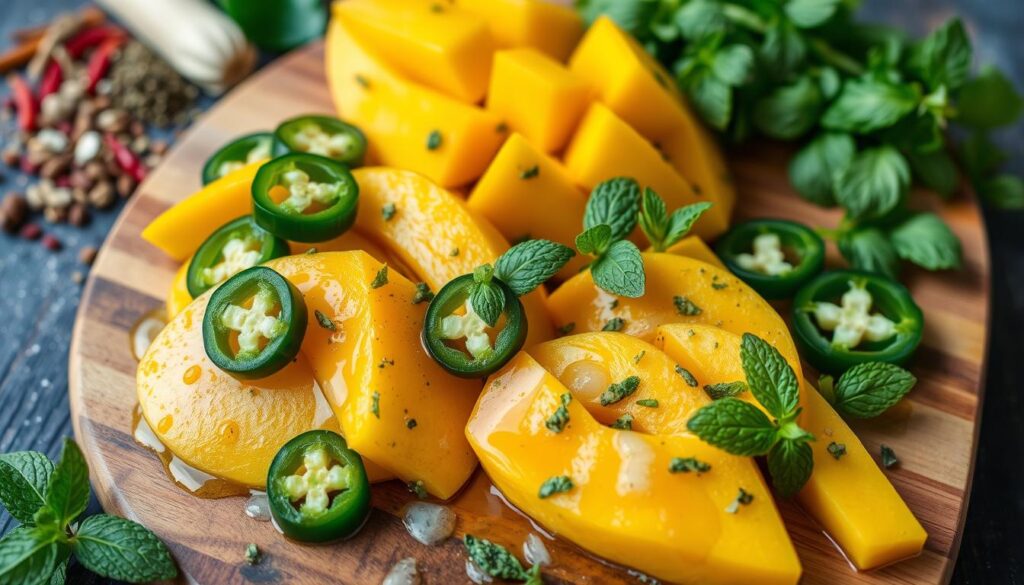
| Flavor Pairing | Main Components | Flavor Experience |
|---|---|---|
| Chocolate with Chili Peppers | Dark Chocolate, Chili | Sweet & Spicy Fusion |
| Kiwi and Oysters | Kiwi, Oysters | Tart & Briny Balance |
Complementary Tastes That Elevate Your Dishes
Exploring complementary tastes is vital for creating remarkable culinary experiences. Taste components such as sweet, salty, sour, and umami can enhance one another, leading to incredible flavor harmony in your dishes.
Salt and Sweet: The Perfect Balance
The contrast between salt and sweetness creates an irresistible balance in cooking. For instance, the addition of flaky sea salt to caramel can elevate the richness of desserts, making the sweetness pop. Other examples include strawberries paired with balsamic vinegar and avocado with lime. These combinations highlight how well two seemingly different flavors can work together, enhancing the overall experience.
Acid and Fat: Creating Harmony
Balancing acid and fat is essential in achieving depth of flavor. The creaminess of avocado or olive oil mixed with the brightness of citrus can lead to an exciting and fresh taste. Incorporating umami-rich elements alongside acidic ingredients, such as soy sauce with lemon or mushrooms with balsamic glaze, reveals layers of flavor. Experimenting with these elements opens up a world of culinary possibilities, allowing you to create dishes that surprise and delight the palate.
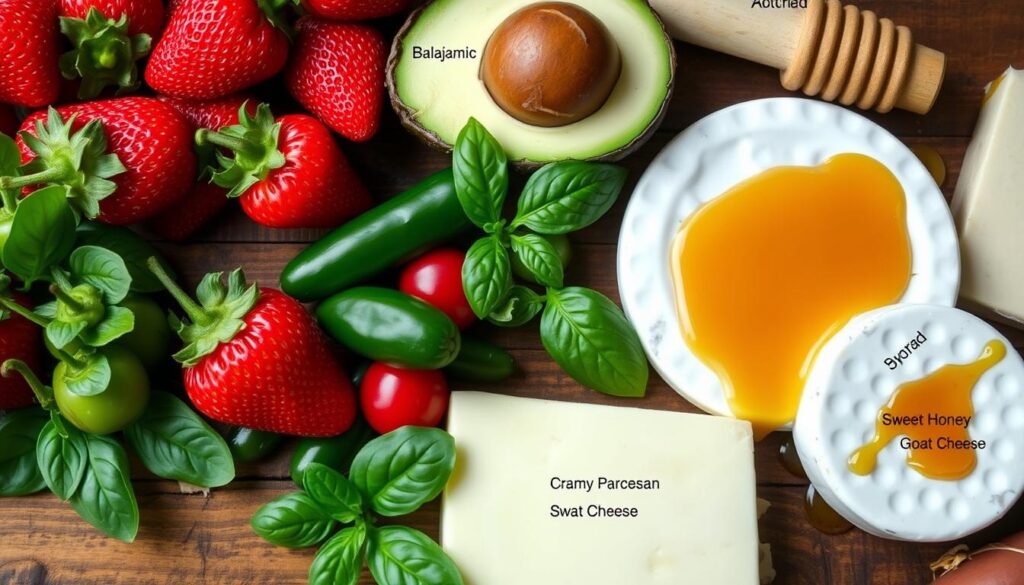
Delicious Flavor Blends for Special Occasions
Creating memorable pairings can elevate your culinary experiences, especially during special occasions. Two standout combinations offer delightful contrasts that charm the palate.
Caramel and Sea Salt
The pairing of caramel and sea salt exemplifies the allure of delicious flavor blends. The sweetness of the caramel harmonizes beautifully with the savory notes of sea salt. This balance triggers a positive biological response in the brain, making every bite not just enjoyable, but memorable. Ideal for desserts or as an indulgent topping, this combination is a fan favorite, particularly when partnered with semi-sweet or dark chocolate.
Raspberries and Dark Chocolate
For a more sophisticated flair, raspberries paired with dark chocolate provide a rich experience for your taste buds. This duo relies on distinct and refined flavors, creating a remarkable balance that elevates any dessert. The tartness of fresh raspberries complements the richness of dark chocolate, making this combination one of the most coveted for special occasions.
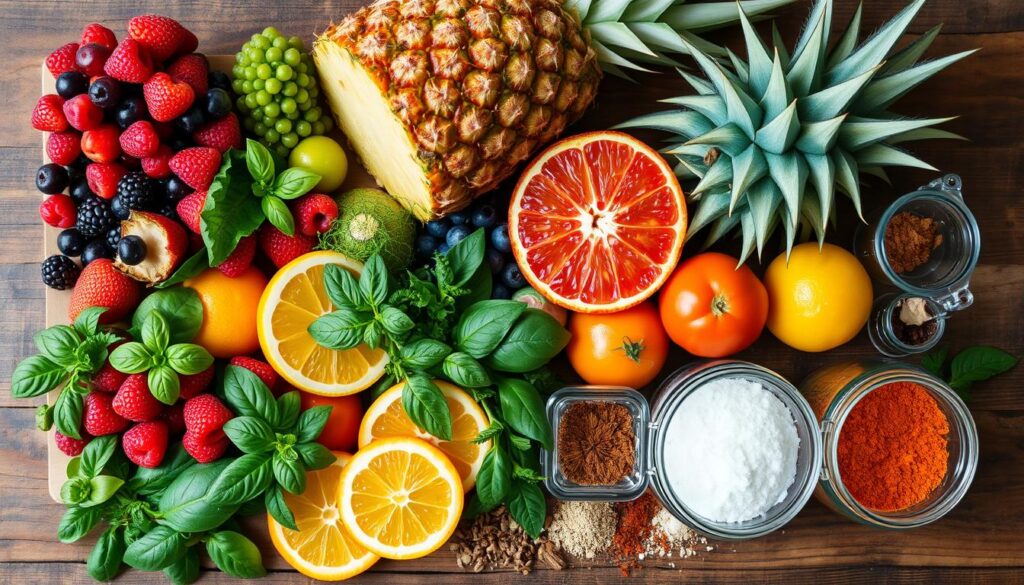
| Flavor Pairing | Characteristics | Ideal Uses |
|---|---|---|
| Caramel and Sea Salt | Sweet and Savory, triggers positive brain response | Top desserts, candies |
| Raspberries and Dark Chocolate | Tart and Rich, refined flavor balance | Elegant desserts, chocolate treats |
Creative Flavor Combinations for Everyday Meals
Transform your everyday meals into exciting culinary adventures by exploring unique and creative flavor combinations. You can elevate familiar dishes, making them more engaging while also igniting your appetite for adventurous cooking. Consider the following pairings that not only enhance flavor but may also surprise your palate.
Garlic Pairing: Enhancing Sweet and Savory
Garlic is a versatile ingredient that beautifully enhances both sweet and savory dishes. Its rich flavor profile complements a wide array of ingredients, making it perfect for various meals. Here are some creative uses of garlic:
- Garlic with artichokes – a classic combination that brings out a delightful mix of flavors.
- Garlic butter paired with sweet options like strawberry jam creates an astonishing contrast.
- In Asian-inspired dishes, garlic can add depth to a tangy pasta salad for a crunchy delight.
Spicy and Cool: A Culinary Adventure
Embark on a thrilling culinary journey by combining spicy and cool flavors. This adventurous cooking style can make your everyday meals more dynamic and enjoyable. Consider these inventive pairings:
- Mix peach preserves with spicy chicken for an exquisite blend of flavors.
- Pair mojito-inspired ingredients like citrus and mint to create a refreshing twist on classic dishes.
- Combine spicy hot sauce with peanut butter in sandwiches for an innovative take that tantalizes the taste buds.

Modern Techniques in Flavor Pairing
As you dive into the world of modern flavor pairing, you’ll discover an exciting blend of culinary innovation and science. Recent advances in biochemistry and machine learning have significantly enhanced our understanding of human taste. These tools open doors to experimental cooking methods that elevate both home and professional kitchens.
One remarkable example of this evolution is the research from foodpairing.com, which explores flavor affinities in over 1000 different ingredients, including vegetables, spices, and juices. This expansive database allows chefs to discover unique, harmonious combinations that may have been overlooked.
When it comes to wine and food pairings, experts like Dr. Paul Breslin from Rutgers University provide valuable insights. His studies demonstrate how taste components such as fat, acid, and astringency impact our palate. For instance, astringent beverages, like red wine and black tea, can complement greasy dishes much more effectively than plain water. Such findings challenge traditional pairing rules while offering fresh perspectives on flavor combinations.
The following table summarizes key insights from modern techniques in flavor pairing:
| Technique | Description | Example |
|---|---|---|
| Flavor Database Utilization | Leveraging extensive pairing databases to identify unexpected combinations | Using foodpairing.com for matching ingredients |
| Astringency in Beverages | Employing astringent drinks to cut through rich or greasy foods | Pairing red wine with fatty meats |
| Understanding Taste Profiles | Exploring sweet, sour, salty, bitter, and umami elements for balance | About matching citrus with delicate proteins |
| Regional Cuisine Exploration | Delving into global flavors for unique culinary experiences | Korean-inspired tacos |

By adopting these modern techniques, you not only enhance your cooking repertoire but also embark on a journey of culinary exploration. Embrace the creativity that comes from understanding chemical reactions in ingredients. Don’t hesitate to experiment with unfamiliar pairings; you could end up creating extraordinary dishes that delight your taste buds.
Flavor Combinations That Surprise
Exploring flavor combinations can lead to surprising flavors that elevate your dishes. You might be amazed by the unexpected combinations that exist in the culinary world, where flavor fusion creates unique experiences. Consider mixing herbs with citrus fruits for a burst of freshness in salads and marinades. Alternatively, pairing cheese and fruit can bring about a delightful gourmet experience that surprises even the most discerning palates.
Herbs with Citrus Fruits
Integrating herbs with citrus fruits not only enhances the aroma but also offers a vibrant palette of flavors. This combination works beautifully in dressings, marinades, and cocktails. For instance, fresh basil or mint alongside citrus can invigorate your seasonal dishes. The citrus notes enhance the depth of the herbs, bringing a refreshing twist that pleasantly surprises your taste buds.
Cheese and Fruit: A Game Changer
The pairing of cheese and fruit can lead to astonishing culinary creations. The creaminess of cheese contrasts beautifully with the sweetness of fruits, resulting in rich and layered flavor profiles. Think of brie with figs, or goat cheese with strawberries. These unexpected combinations allow for endless creativity, enhancing charcuterie boards or adding flair to desserts. A well-chosen jam with different types of cheese offers a delightful surprise, blending surprising flavors in every bite.
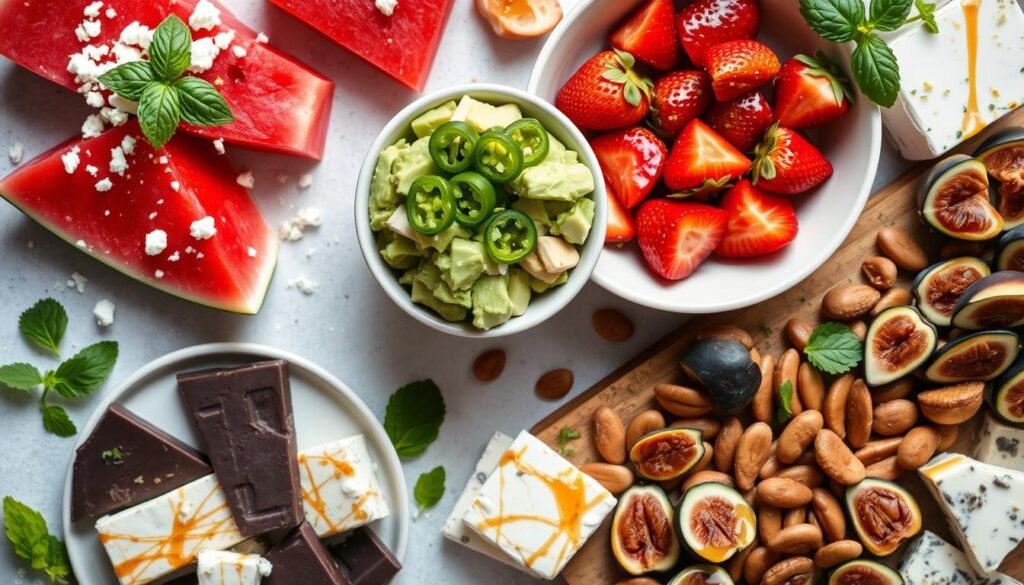
| Flavor Pairing | Description |
|---|---|
| Herbs with Citrus | Combines freshness with tangy notes, perfect for marinades. |
| Cheese and Fruit | Brings richness and sweetness together, ideal for gourmet experiences. |
| Mango with Chile & Lime | A traditional snack with a burst of sweet and spicy flavors. |
| Chocolate with Chili | A historical pairing that enhances the depth of chocolate. |
| Strawberry & Balsamic Vinegar | A refreshing combination, perfect for salads or desserts. |
Engage your culinary instincts by trying these combinations. The beauty of flavor fusion lies in the surprises that enhance your cooking experiences, opening doors to exciting new dishes that thrill and delight.
Global Fusion: Merging Culinary Influences
Exploring the concept of global fusion opens a vibrant world of culinary influences that inspire innovative cooking. By merging traditional techniques and flavors from various cultures, chefs create unique dishes that celebrate diversity on your plate. This international cuisine inspiration allows for endless possibilities in the kitchen, as chefs are able to experiment with different ingredients and cooking methods. The result is a melting pot of flavors and textures that tantalize the taste buds and showcase the beauty of cultural exchange through food. From Korean tacos to Moroccan-spiced lamb burgers, the global fusion trend continues to push the boundaries of traditional cooking and redefine what it means to create a memorable dining experience.
Korean Tacos: Bold and Balanced
A prime example of global fusion is the Korean taco, where the robust flavors of Korean barbecue collide with the versatile format of a taco. This dish seamlessly fuses spicy bulgogi, refreshing kimchi, and zesty toppings inside a soft tortilla. You’ll experience a bold and balanced flavor profile that showcases the magic of culinary influences from both Korea and Mexico.
Middle Eastern Spices for Western Dishes
Another exciting avenue in innovative cooking is the use of Middle Eastern spices to elevate classic Western recipes. Ingredients like za’atar and sumac can add depth to roasted vegetables, meats, or even pasta dishes. By incorporating these spices, you transform familiar meals into tantalizing experiences, reflecting the beauty of global fusion on your dining table.

The Science Behind Flavor Pairing
Diving into the science of flavor pairing reveals fascinating insights into the relationships between various ingredients. By utilizing the flavor wheel, chefs and home cooks can categorize flavors effectively, helping to identify harmonious ingredient combinations. This understanding extends to the underlying chemical compounds that create flavor harmony, an essential component for achieving delicious results in the kitchen.
The Flavor Wheel
The flavor wheel serves as a visual guide to explore the connections between different flavors. It categorizes flavors into distinct groups, enabling you to see how certain taste profiles align. For instance, a typical Western approach focuses on ingredient pairs with shared chemical compounds, which statistically correlates with a higher success rate in enhancing culinary experiences. 56,498 recipes have been analyzed, showcasing a trend where Western cuisines particularly thrive on such pairings.
Chemical Compounds and Flavor Harmony
Understanding the role of chemical compounds is crucial for the science of flavor pairing. Elements such as esters, terpenes, and aldehydes contribute significantly to the overall flavor profile of dishes. For instance, ingredients like chocolate and coffee share aroma compounds, making them a scientifically sound choice for pairing. Professional chefs often use this knowledge to exploit natural chemical reactions between ingredients, sparking bold flavors and elevating taste experiences.
In contrast, regions like East Asia tend to avoid ingredient pairings that share these compounds, opting instead for distinctive flavors that stand alone. This diversity in approaches provides a wealth of culinary creativity. Experimenting with contrasting elements – such as sweet and tangy or sharpness with earthiness – enhances the potential for creating balanced dishes that captivate the palate.

Tips for Mastering Flavor Combinations
To truly excel at mastering flavor combinations, one must embrace a spirit of experimentation. Allowing yourself to explore different ingredients can elevate even the simplest of dishes. Emphasizing this process not only expands your culinary creativity but also helps you develop a deeper understanding of how flavors interact.
Experimentation is Key
Your journey in the kitchen will flourish through hands-on experimentation. This involves playing with the primary flavors—sweet, salty, sour, bitter, and umami. Notable moments can arise when adding unexpected ingredients. For example, try incorporating spicy elements like sriracha or Tapatio to balance sweetness or sourness in various meals. The most common mistake among Top Chef contestants is under-seasoning, highlighting the importance of seasoning and flavor adjustment during cooking.
Utilizing a Flavor Pairing Database
Integrating tools like a flavor pairing database can streamline your culinary experiments. These databases offer valuable insights into which flavors complement each other, serving as a guide to enhance your dishes. With information on how sweetness can balance bitterness or sourness, you can better navigate adding ingredients like honey, soy sauce, or vinegar. Remember, achieving balanced flavors requires both science and creativity, ensuring a delightful dining experience.

Conclusion
Exploring flavor combinations is a vibrant journey, allowing you to elevate dishes into extraordinary culinary experiences. Professional chefs understand that mastering the art of food pairing not only enhances flavor profiles but also highlights the subtle nuances of each ingredient. By embracing diverse regional cuisines, you can uncover unique pairings that delight the palate and expand your culinary repertoire.
As you delve into culinary exploration, consider the balance of sweet, sour, salty, bitter, and umami flavors to create harmony in your dishes. Experimentation with herbs and spices can yield astonishing results, as contrasting elements like sweet and tangy flavors contribute both balance and visual appeal. The insights from renowned chefs illuminate the significance of timing and sequence in revealing the dynamic complexity of flavors, broadening your understanding of how to craft exceptional meals.
Ultimately, the more you experiment, the more satisfaction and creativity you’ll discover in your cooking. Embrace the journey of exploring flavor combinations, and watch how your dishes transform into memorable culinary creations that captivate your guests and elevate your home dining experiences.
